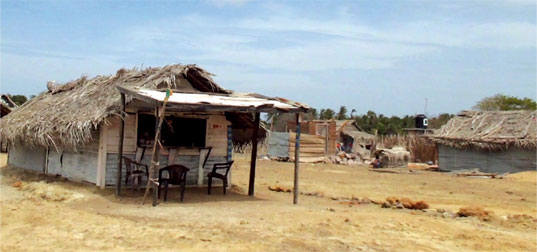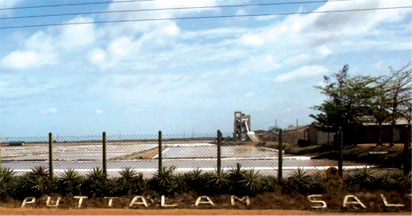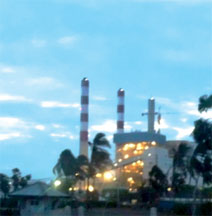|
Kalpitiya:
The scenic coastal town of diversity
by Ganga Ratnayake
|

A fishing village
|
August 30, 2012 was a busy morning for us. Despite the gloomy weather
we set off on a long journey which took us all the way from the hill
capital to the far away Northwest coast. Our destination was Kalpitiya,
a coastal town overlooking the Puttalam lagoon, the second largest
lagoon of Sri Lanka.
After reaching the Kurunegala Road we passed the towns such as
Katugastota, Kurunegala, Wariyapola, Nikaweratiya, Anamaduwa and Kalladi
until we reached the junctio+n where we turned to Palavi Road.
And once crossing the Palavi Road at the next junction we turned
towards Kalpitiya Road and went passing Mampuri, Nuraicholai
(Norochcholai), Alankuda, Eththalai, Palakkuda and finally the town of
Kalpitiya.
Our path fell along the A10 route which was an almost straight path
beautified and shaded by trees neatly aligned. Bit by bit the rolling
blue hills dwindled from our vicinity and the skyline was replaced by
palm trees. We were passing through the coconut triangle, where acres of
coconut estates sprawled as far as the eyes can see. These trees were
not so tall, and we even saw some people plucking coconuts from the
ground using long picking sticks. Popping up from here and there amidst
them were some palmyrah trees, iconic to the northern zone.
As we drove along the thin strip of land across the peninsula, we saw
the lagoon water and the distant blue ocean peeping between small huts
and palm trees. Being fishing villages the sandy white shores were
dotted with fishing boats of various bright tones. We also passed a
number of salterns drying sea salt in open air under the warm tropical
sun. Along the borders of each saltern were big salt mounds snuggled
under covers. After some time we spotted dozens of small huts where fish
were cured and dried using traditional methods.
The sights and scenes en route changed every now and then which made
the excursion more interesting. We saw dwellings of all sizes and
comforts varying from small clay huts to three-storey air-conditioned
apartments. Yet one thing common to this area was that their roadsides
were conspicuously adorned with flowering trees. Flowers of vivid
colours breathed life to their mundane lives. Even their boundaries were
marked with palmyrah leaf walls, which created floral patterns
delightfully.
|

Puttalam saltern |
A few minutes after passing the Kalpitiya town we finally reached the
Vijaya Naval Base. The place looked wonderfully serene and enchanting,
overlooking the unruffled waters of the lagoon. Here we relished a
guided tour around the historical Dutch fortress resting within the
premises of the camp. And thereafter we headed to the pier and after
hopping across three boats we settled inside a nice big boat with seats
topped with a canopy. After putting on lifejackets the boat took us on
an exciting ride across the lagoon. We saw at the far end of the lagoon
a thin strip of land teeming in lush greenery, which turned out to be
the famous Wilpattu National Park. The lagoon also nestled green islets
and many fishing boats, some anchored all along the Kalpitiya harbour.
We were even surprised by a nice splash of wave foam showering us in
salty water, right when the boat turned to head back.
Later that evening on our way back we visited the Nuraicholai
(Norochcholai) Navy camp where we got a chance to see the Norochcholai
coal power plant from close proximity. The scenery was fascinating, as
on one side was the imposing coal power station and on the other side
were the gigantic wind turbine towers. One of the Navy personnel
enlightened us about both power plants including the magnitude of their
services.
We heard that the Norochcholai coal power plant spreads across over
100 acres and it was initiated in May 2006. It is built in three phases
and once completed will generate a supply of 900 MW of electricity to
the entire island. At present it can supply about 300MW where a tenth of
the power is used to run the plant. The station is operated and funded
by five Chinese companies and over thousand Chinese engineers and
technicians work at the plant and the construction site. The main fuel
coal is imported from Indonesia, and the shipments are brought to the
yard with the help of tugboats.
|

Norochcholai coal power plant |
While watching the power plant illuminated in bright lights all
around, we felt the strong wind blowing from the sea close by. To catch
this strong wind the coastline nestles several giant wind turbine
towers. Even its smallest gearbox behind the hub of the rotating blades
is said to be as big as a double door bus! We also heard that their
rotating blades are highly efficient and flexible, and can be titled and
turned to any angle or direction. Despite being cost effective, the wind
turbines can be built only in places where the strong winds are
available constantly.
Kalpitiya and its nearby towns are home to a multiracial community
living in harmony, as we saw en route numerous churches as well as some
temples and mosques. Thus, we didn't miss a chance to visit the oldest
church in Sri Lanka, the renowned Talawila Church, which rests
overlooking the scenic shoreline. The Talawila church is adorned with
elegant architecture, beautiful sculptures and charming green backdrops.
And the church is visited by people from all races and religions to
invoke the blessings of the revered St. Anne. As in a temple, there were
signs to remind the devotees to come clad in decent clothes and remove
shoes before entering the nave.
The last stop of our trip was the Karambe temple, where we had the
opportunity to speak to the young priest who was rendering a service to
the community.
As we entered the newly built shrine room I noticed it had a unique
hexagonal shape with an interior full of beautiful murals. As we stepped
into the sandy court of the Bodhi tree, we noticed a few feet tall Bo
plant right next to the big Bo tree.
This small plant was a sapling from the sacred Bo tree in Bodhgaya,
India which was planted simultaneously with other saplings around the
country, to bless the citizens following the tsunami devastation.After
leaving the temple we headed home while the sights around us began to
vanish into darkness. Yet the chilly breeze and the salty air reminded
us that we were still passing through the coastal villages of the
Northwest now in a tranquil slumber.
|


